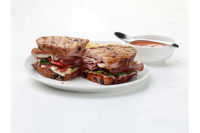Wrapping Up Deli Success
by Richard Mitchell
Packaging plays a critical role in the success of retail deli meat products.
To gauge the state of retail deli packaging, The NATIONAL PROVISIONER interviewed six industry experts:
- Allen Hankins, brand manger for Cincinnati-based John Morrell & Co.’s Kretschmar line of deli products
- Robert E. Hogan, director of sales and marketing for Zip-Pak, a Manteno, IL-based provider of resealable packaging products
- Bob Koch, director of sales in the food division for Kansas City, MO-based Multivac Inc., packaging equipment manufacturer
- Larry Rebodos, marketing manager for packaging provider Pactiv Corp.’s Lake Forest, IL-based Hefty Slide-Rite division
- Tom Winter, product manager for Appleton, WI-based Presto Products Co.’s Fresh-Lock brand of zippers
Alan Warren, director of meat and seafood for Richmond, VA-based Ukrop’s Super Markets Inc., a chain of 28 grocery stores located in central Virginia.
Here’s what they had to say on a number of topics:
NP How has retail deli-meat packaging changed in recent years?
Hogan: There are more convenience features. Packages are easier to open. But the most significant development is the addition of the slider zipper, which has occurred within the last few months. A conventional press-to-close zipper adds 2 cents to the cost of a package, and the slider adds 5 cents. But they are pretty affordable, especially in comparison to food-storage bags. If it were not for the zippers on deli-meat packages, consumers would think nothing of taking their products home and then placing them in 15-cent Zip-Lock bags.
- Allen Hankins, brand manger for Cincinnati-based John Morrell & Co.’s Kretschmar line of deli products
- Robert E. Hogan, director of sales and marketing for Zip-Pak, a Manteno, IL-based provider of resealable packaging products
- Bob Koch, director of sales in the food division for Kansas City, MO-based Multivac Inc., packaging equipment manufacturer
- Larry Rebodos, marketing manager for packaging provider Pactiv Corp.’s Lake Forest, IL-based Hefty Slide-Rite division
- Tom Winter, product manager for Appleton, WI-based Presto Products Co.’s Fresh-Lock brand of zippers
Alan Warren, director of meat and seafood for Richmond, VA-based Ukrop’s Super Markets Inc., a chain of 28 grocery stores located in central Virginia.
Here’s what they had to say on a number of topics:
NP How has retail deli-meat packaging changed in recent years?
Hogan: There are more convenience features. Packages are easier to open. But the most significant development is the addition of the slider zipper, which has occurred within the last few months. A conventional press-to-close zipper adds 2 cents to the cost of a package, and the slider adds 5 cents. But they are pretty affordable, especially in comparison to food-storage bags. If it were not for the zippers on deli-meat packages, consumers would think nothing of taking their products home and then placing them in 15-cent Zip-Lock bags.
Koch: The slider is the latest evolution, and it is a much more reliable way to open and close the zipper. There was an indication from our focus groups that the press-to-close zippers were not the ultimate in ease of use because some people had difficulty aligning the zipper so it would close properly each time.
Warren: With the aging of baby-boomers, hand strength for many is not what it used to be. Being able to open packages more easily is something retailers are hearing about frequently from consumers. Companies also are offering rigid, reusable, container-type packaging. These GladWare or Tupperware-type containers (for thin-sliced meats) are the hottest things in the processed meat case right now. Hillshire Farm is having the best success with it. The container is washable and reusable for storing leftovers.
Hankins: The meat and poultry industries have been around for a long time. And aside from what’s in the product itself, there is nothing to differentiate one brand from another. With these newer, higher-end packages, you’re also better able to convey freshness, convenience, and that the meat is worth the money.
NP What are your customers requesting in terms of packaging for pre-packaged deli meat and poultry products?
Warren: Convenience is the key word right now. Anything we can do to provide the customer with more convenience in opening and closing the package is going to pay big dividends.
Winter: They want packaging that will keep the product fresh until it is used up. Disposable containers and the slider also enable consumers to keep the product in its original packaging when it is refrigerated. That also helps the processor because your brand and name awareness stays in front of the customer. You lose that identity when the consumer takes the product out of the original package and puts it in a generic storage bag.
Hankins: Consumers also want smaller packages because they are coming into stores more frequently. And because you’re offering a premium product, you want to sell it in a package that’s going to keep the integrity of that product. You can have a rigid package that gets stuck, and then end up with meat flying out onto the table when users finally pop it open. That doesn’t speak very highly about the way you get your product to the consumer. You want to make it easy and convenient for them.
Koch: More of our customers — the processors — also are requesting packages with an appearance that indicates the product might have been packaged at a local level, or in the store. With the slider, it’s not inconceivable that the meat could have been placed in the package from a store’s back room.
NP What is your company’s newest packaging for deli meat and poultry?
Hogan: The thermoform application for the Zip-Pak Slider. Plumrose USA is using the slider for its 8-ounce line of Danola Supreme Deli Classic meats. The slider mechanism, slides smoothly across zipper tracks for easy opening and closing.
Rebodos: The Hefty Slide-Rite Advanced Closure System. The slider is being used on Hormel Foods’ premium sliced deli meats. Our system can bolt to the OEM original equipment or existing equipment. It’s a pretty flexible system.
Hankins: The Zip-Pak resealable packaging that we’ve been offering for about a year. We use it on our 8-ounce pre-sliced deli meat line. The main feature is it’s pegable. You can hang it up or lay it in the bunker. We try to focus on getting it up on the peg so the consumer can see it.
Winter: The press-to-close Fresh-Lock Zipper. We’re also working with a couple of our customers on disposable container-type packaging, but it’s not commercial yet. We also have a slider package, but it, too, has not yet been commercialized in the deli-meat area.
NP What are the biggest challenges facing meat and poultry processors regarding packaging for deli products?
Hankins: There are only so many ways you can pack a ham, turkey, or roast beef. Probably the biggest challenge is finding new ways to differentiate the products. While Coca-Cola could revolutionize packaging overnight and almost create a new product, deli hasn’t been one of the industries that has done that.
Hogan: The biggest challenge for some processors might be the cost of entry to support the zipper. Machinery can run from $250,000 to upwards of $400,000 to $500,000, depending on features. But there are companies offering to do conversions and retrofits of existing machines that would make it a little bit more affordable for smaller firms.
Rebodos: The United States has traditionally been behind Europe and Japan in moving to higher-technology packaging. Consumers’ level of sophistication and demand for packaging performance is much higher in those other regions. The size of the United States also makes it much tougher to move new packaging into the mass market. In Switzerland, for instance, which is the size of Connecticut, there would be a much lower upfront investment cost.
Koch: It also takes a long time for new packaging to take hold because of the marketing issue. And it is very expensive to set up a new packaging line. Not only because of the capital investment in the equipment, but because of the need for additional space in the plant. “You also have to first be sure that consumers will accept the product. It’s difficult for a company to say, ‘Well, lets try it, and if it doesn’t work then we’ll do something else.’”
NP How is packaging for deli meat and poultry products likely to change in the future?
Winter: The question is, will the market be going to rigid containers, like the disposables? Is it going to be the slider? Or is it going to be a new package format that someone will come up with? These things usually evolve. But it takes quite a dramatic package change to make everyone go, ‘wow, that’s it,’ and then jump on it. People are most comfortable with what they know, and are somewhat cautious about making a big change. The changes will be driven by the packaging options that are available and the demand for freshness. Packaging also has to be designed so it easily fits in retailers’ display cases.
Koch: We’ve delivered in excess of 200 press-to-close zipper machines, so the market’s pretty well covered with that kind of package. It doesn’t have the same cachet that it did a few years ago. So companies looking to better differentiate themselves will be looking at improved zippers, such as the slider.
Warren: You will always have entrepreneurial, pioneering-type companies trying to be on the cutting edge in terms of offering the latest and greatest convenience-oriented consumer packages. We’re already seeing companies use better films that minimize leakage and improve clarity. By providing better visibility of the meat, the product is more attractive and the meat becomes more appetizing.
Rebodos: Press-to-close packaging has been used for cheese since around 1985, and it ensued on deli meats about five years later. So if evolutionary history repeats itself, we should soon be converting a good portion of the marketplace over to the slider, which has only been offered on consumer-brand packaging since about late 1998. It takes time to develop the technology that can bolt onto manufacturing equipment to produce these newer packages.
Richard Mitchell is a Chicago-area freelance writer.



Report Abusive Comment